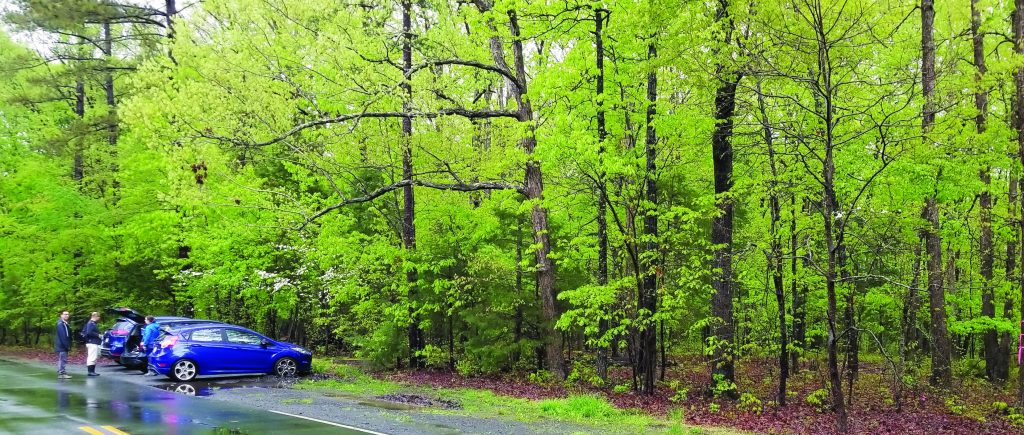Greg Fitch, President, North Carolina Botanical Garden Foundation
The North Carolina Botanical Garden Foundation, the support organization for the Garden, expanded the scope of habitats it protects in July when it purchased a beautiful forested hillside on the boundary of North Carolina Botanical Garden nature preserves.
Called the Cochrane property, it borders the Parker Preserve to the north, Mason Farm Biological Reserve to the east, and the Laurel Hill Nature Preserve to the west, and it provides an increased buffer against inevitable development. Trails through the property will provide access to the Garden’s established trails leading to Mason Farm, and adjacent parking makes this a convenient alternate entrance. This enhances the public’s enjoyment of all the Garden has to offer.
The Garden received administration of the Parker property in 2012 and created the Parker Preserve. The Parker property was donated to the university in 1976, because, in Athena Parker’s words: “We are trying to impress on people that this is an important piece of land. And that we want to help the university further its conservation effort. The natural beauty is something that should continue to be appreciated.”
Sadly, Bill Parker passed away in 1997, followed by Athena Parker in 2002, but their land conservation wishes were ultimately realized. It was at a small memorial service for Mrs. Parker in the Paul Green Cabin at the Garden that Johnny Randall and former NCBG development director Charlotte Jones-Roe met Shirley Cochrane. There Mrs. Cochrane, a Chapel Hill native, relished the 1960s folk songs that celebrated the spirit of Bill and Athena Parker, and they learned of her fond memories for both individuals. They also learned of her adjacent property and its natural value. We stayed in general contact with the Cochrane family, and hoped to conserve their property, if and when they ever decided to sell. After Mrs. Cochrane’s death in 2015, we pursued land purchase in earnest.
The 13-acre parcel was purchased from the Shirley G. Cochrane Trust and directly abuts the 125-acre Parker Preserve. It is fitting that the lands of neighbors Shirley Cochrane and Bill and Athena Parker are conserved, and that their love of forests and wildlands will forever be honored.
With a sales price of $725,000, the Cochrane property was no easy task to finance! The Foundation sold several residential parcels it had received over the years and had held for investment purposes. Proceeds were dedicated exclusively to this purchase (former Foundation president Bill Bracey of Franklin Street Realty listed and sold both parcels so we knew we were in good hands). Generous contributions also came from Orange County, the Town of Chapel Hill, private donations, and a substantial grant from the NC Clean Water Management Trust Fund.
The Cochrane property is ranked exceptional by the NC Natural Heritage Program. Acquiring the Cochrane property extends contiguous natural areas the Garden administers, and protects an extraordinarily intact mature basic dry oak-hickory forest that extends through Mason Farm and the North Carolina Botanical Garden display gardens. On an even bigger scale, these lands, along with nearly 200 acres of nearby undeveloped private land holdings, make up a significant wildlife corridor associated with the 42,000-acre Jordan Lake Gameland.
Jim Pick, chair of the Foundation’s conservation committee, said, “The success of this acquisition is the result of many years of persistence and hard work on the part of its key driver, Johnny Randall.” And in fact, there were setbacks and delays over the years but Randall, NCBG’s director of conservation programs, just kept moving ahead, ever optimistic and unbowed.
Some Garden supporters may be unaware the Foundation not only financially supports the Garden but serves as a land trust on its behalf. In fact, in the Foundation’s founding Articles of Incorporation, its mission is “to receive funds, and to hold lands, regardless of geographic location, for the use of the North Carolina Botanical Garden in carrying out its objectives of conservation, scientific investigation, teaching, public service and public recreation.” Including Cochrane, the Foundation now holds 112 acres of nature preserve, and 199 acres of conservation easements.
The additional land will also provide an area in which to continue scientific studies of the flora and fauna that inhabit the tract. UNC classes in environmental literature and geography have already conducted tree inventory studies, and more projects are planned.
